XCR - Expedition Double
Sailing Canoe
|
|
|
Design by Chris Ostlind- Salt Lake City, Utah - USA |
| XCR SPECIFICATIONS: |
Length Overall |
- |
18’6” |
Length at Waterline |
- |
18’ |
Beam Overall (canoe hull only) |
- |
35” |
Beam Overall (amas extended) |
- |
10’ |
Beam at Waterline (canoe hull) |
- |
32.5” |
Displacement |
- |
750 lbs |
Sail Area |
- |
100 sq ft. |
Sail Area/Displacement |
- |
19.38 (cruiser/racer) |
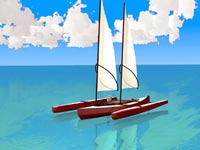 |
I enjoy canoes that are designed as small, lightweight trimarans as I feel they present the greatest number of solutions for serious, expedition sailing
(click images for larger views) |
|
I have a very serious passion for sailing canoes. Principally, I enjoy canoes that are designed as small, lightweight trimarans as I feel they present the greatest number of solutions for serious, expedition sailing with few of the compromise limitations the sailing canoe genre can represent.
I wanted to design a big boat; something out around 18’+ with a modest beam for the length in the 35” neighborhood and the ability to carry a hefty expedition load without sinking the hull too much or hammering the freeboard. Canoes that long with beams of 35”, or so, have a real chance of being quite fast under paddle if the hull is shaped correctly.
There are some really fine boats out there that could, in the right hands, become very good cross-over sailing canoes when equipped with outrigger floats (amas) and a well thought-out rig setup.
One of my favorite sources of inspiration was the John Winters designed, Cirrus.
About six years ago, I had a conversation with John Winters in which he told me that there had been a decked Cirrus prototype built at one time by Swift Canoe. He indicated that the design had not been further explored in that manner and it’s sitting on a rack somewhere out behind the Swift Canoe shop. The idea of a hard decked canoe for adventure sailing was very appealing, so I stashed the concept while I worked on other design questions.
| I stretched the length out to 18’6” to be able to handle the heavier loads. |

|
|
Like the decked Cirrus, I was looking to include an integrated hard deck on the XCR design to replace the soft, full coverage spray skirt setup typically seen on expedition boats of this type. The deck would also provide incredible strength to the hull and allow for a fairly aggressive sail rig as a result.
When I plugged the Cirrus numbers into my design software, along with a rough approximation of the hull shape, I found that I was going to be compromising a bit on the targeted design displacement of 800 lbs. So, I stretched the length out to 18’6” to be able to handle the heavier loads.
The other standard for boats of this type is the highly respected, Kruger Cruiser. The Kruger boat is built like a tank with 11 layers of Kevlar along with a heavy gel coat. Because of the design requirements, there is a vast chasm of build level between the normal, recreational canoe and one that is ready for serious expeditions in remote locations. While I respect the boats, as well as the owners of the Kruger Company, I don’t think that most adventure canoeists will ever need to have a boat that is built to that level of expense. For the “way out there” expeditions in which your very survival is dependent on the ability of your boat to hold together in harsh conditions; Yes, the Kruger style of boat is appropriate. For everyone else, a much lesser degree of build technique is more than adequate.
Take a look at what types of canoe adventures were accomplished by explorers before Kevlar ever reared it’s head from the chemistry vat at DuPont.
With the XCR, once you meet the basic level of structural properties of the design, you get to make the laminate decision yourself. If you like, you can give the interior of the hull several layers of Kevlar set in epoxy, along with four layers of S-Glass on the high wear areas outside for an expedition layup. You will end-up with a structural toughness to match the Kruger boats.
Or, you can go “expedition lite” on the layup, hold-off on some of the big dollar laminates and have much lighter, more easily portaged boat as a result.
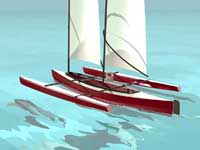 |
Take a look at what types of canoe adventures were accomplished by explorers before Kevlar ever reared it’s head from the chemistry vat at DuPont.
|
|
Displacement vs Capacity Numbers
Perhaps I should provide a brief explanation of just what is going on in the canoe world with all the load numbers you see in brochures and various Internet sites.
Many designers put together a hull shape with a specific design displacement weight in mind. This is the total, all-up, weight to which the hull is designed for optimal performance. For one reason or another, many manufacturers like to give a number that indicates the hull capacity and it’s usually way up above the displacement number. While it is true that most canoes can safely carry the higher weight without too much of an issue, the boat will not perform anywhere close to the design displacement weight as indicated by the designer.
Sometime soon, I’ll write an article about canoe loading safety as there are many issues to discuss in that area and this article is not the place for the material right now.
Hull Design
The XCR is a decidedly asymmetric hull form. Unlike the more traditional styles, the widest part of the underwater shape is behind the center of the boat. This design style aids in the hull’s ability to track smoothly in a straight line among other benefits.
| Normally, added rocker makes for a boat that always wants to turn, but the asymmetrical hull counteracts that effect. |
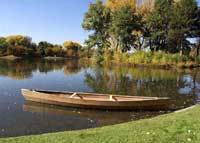
|
|
Because a sailboat has to be responsive to helm input, the XCR has considerably more bow and stern rocker than a typical tripping canoe. Normally, added rocker makes for a boat that always wants to turn, but the asymmetrical hull counteracts that effect. The result is that the boat has many of the best characteristics for a tripping design. She wants to run straight when you have a big crossing to take on and she will turn on a dime with subtle steering input.
The XCR is designed to be built from marine plywood with 6oz. glass skins in epoxy on both the inside and out. The build techniques are straightforward and easily accomplished by the homebuilder. I estimate the building costs for this boat, complete with sail rig, amas, aka beams, foils and hardware to be right around $3000. When you compare this price to the cost of just the Kruger Cruiser at $4200 without the sail rig or outriggers, you can immediately see the value of building your own XCR exactly the way you would like.
The Rig Setup
For the rig, I wanted a setup that could be extremely adaptable to a wide range of wind and sea conditions as well as provide for some very nice performance potential. I chose to install a pair of half-wishbone, sprit rigged sails, each about 50 sq. ft. in area. I may, in fact, end up with a ketch rig by increasing the sail area of the forward sail and decreasing the aft rig. That’s still out there in the to-be-determined category and can be chosen by the builder. As a rig platform, the XCR is quite versatile, as long as the intended rig does not interfere with the objective purpose of the mission of the hull in the first place.
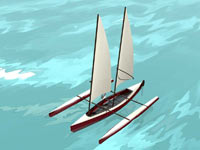 |
Both sails can be aloft at the same time.
They can both be reefed equally for rising conditions. |
|
For this design study, I went with the matching rigs. The layout of the very large cockpit is such that the crew can have the following rig setups:
Both sails can be aloft at the same time.
They can both be reefed equally for rising conditions.
The aft rig can be doused completely and stored with the forward rig being moved to a central stepping location and have the boat sailed as a sloop.
The forward sail can be doused along with the deployment of a sea anchor and a reefed mizzen can be left up for control in very serious conditions.
Cockpit Layout
The cockpit is sized to allow for the breakdown and storage of the rigs within the hull. There will be a large, cockpit rim around the opening to shed water and provide structural strength to the deck. The standard, fore/aft canoe paddling positions are left intact. There will be two, glassed-in, thwart tubes at the outrigger beam (aka) locations. These tube thwarts will replace the traditional, flat wooden or aluminum tubing thwarts of more familiar canoes.
This approach is borrowed from the manufactured Kruger Canoes. Kruger uses these tubes for the function of joining two boats together in a catamaran style. I’m not especially fond of the catamaran mode for sailing canoes with this method. I feel that a fully loaded canoe has the potential to generate serious loadings on any potential, inter-hull connector in this manner in all the path axes. A boat designed from the beginning to be “catamaraned”, if you will, would have substantially stronger, hull mounting points as well as stronger connecting beams.
The seating in the XCR will be addressed in a similar fashion to that of the previously shown Tribal Menace. The seats will be infinitely adjustable fore and aft, up and down and also in pitch fore and aft. This means that the crew will be able to set a seat height, get into a flow for an extended period of time and when their bodies start to feel the results of a fixed position, they can adjust it slightly to get into another comfort zone. The seats are also totally removable to allow for a huge range of use with the boat.
Because of the rather long interior volume, one crew member can slip below to take a nap prior to their turn on watch while the boat can be sailed by the other crew member.
| The seats will be infinitely adjustable fore and aft, up and down and also in pitch fore and aft. This means that the crew will be able to set a seat height, get into a flow for an extended period of time and when their bodies start to feel the results of a fixed position, they can adjust it slightly to get into another comfort zone. |
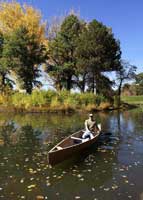
|
|
Foils
The two foils used on the XCR are optimized for the sailing range of the boat as well as for utility of the boat’s application. That means that the foil sections and planform are selected to operate within the sailing speeds that can be generated by the rig and the hull shape. I prefer higher aspect foils for a number of reasons; mostly because they work well when the boat is sailed quickly and there’s no penalty for the extra draft if they are of the kick-up variety.
The keel form is handled through a leeboard arrangement. The mount for the leeboard is removable from the hull/deck mount to allow the canoe to be paddled without the extra baggage of the mount. Both the rudder and the leeboard are the “kick-up” variety to keep the boat from being damaged by an underwater obstacle or when beached with the foils down. The leeboard simply rotates up through an aft arc and the rudder flips up in a similar fashion.
Outrigger System
The amas are designed to be crafted from marine plywood in a stitch and glue style of construction. They will be quite light and will mount to 6061T6 aluminum tube sections for aka beams. Builders of the design will also have the option to construct their own, “gull wing” akas if they choose. Full length trampoline surfaces can be affixed between the fore and aft akas as can hard, hiking platforms. The hiking platforms will allow the crew to sit out on the benches, providing additional righting moment for faster sailing potential.
The aka tubes are sectioned to allow easy take-down and setup of the outrigger assembly. They are held together with the same stainless snap buttons that you see on take-a-part paddles. There is a removable aka section on each side of the canoe hull for each aka tube. Once removed, the ama can be remounted to the hull for transport, OR, the ingenious owner can then use the canoe with the amas in place for a whole new set of possible water-borne adventures. How about duck hunting from your canoe with no danger of tipping over at all? How about taking the grandkids out for a day of fishing on the lake without having your daughter get on your case about being careful with the kids? The potential is quite wide open.
 |
The amas are designed to be crafted from marine plywood in a stitch and glue style of construction. They will be quite light and will mount to 6061T6 aluminum tube sections for aka beams. |
|
The images supplied show the renderings of the proposed finished boat as well as photos from the first, on the water, paddling test of the hull without its deck installed.
The XCR paddled wonderfully in the test. It is fast, tracks well and responds to turning strokes like a much smaller boat. The bare hull was weighed at 51 pounds. I expect this canoe to be ideal for sailing or paddled adventures. The XCR can easily take enough gear and supplies to last for a two week adventure on the water, so the horizon is really wide open as to where this boat could go.
The hull shape and construction will be seaworthy in anything from calm lakes to fairly heavy conditions. This boat can serve as a serious expedition machine and would be serious contender for a honed and fit two-man crew in such coastal adventure races as the Watertribe Everglades Challenge.
Chris Ostlind
Lunada Design
[email protected]
|